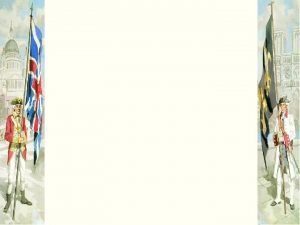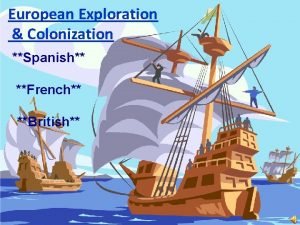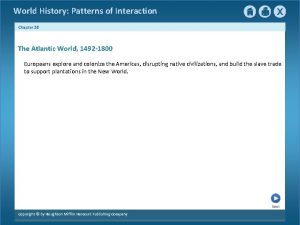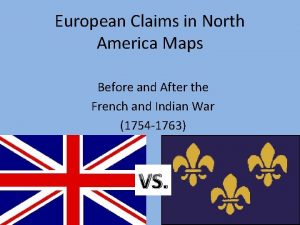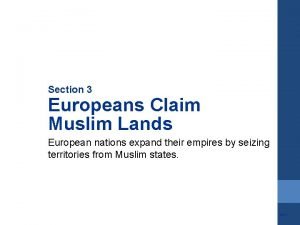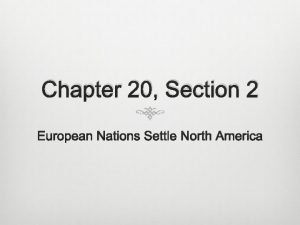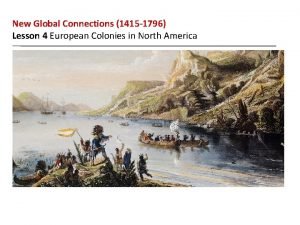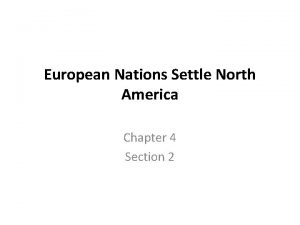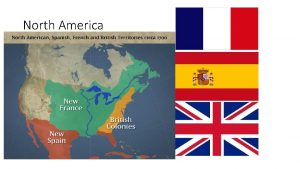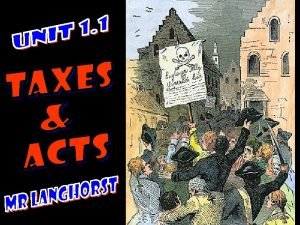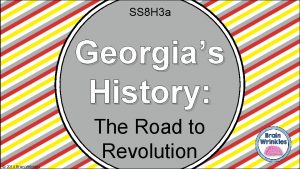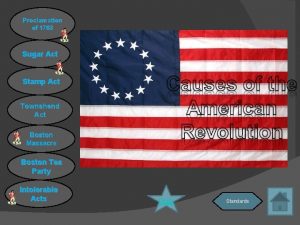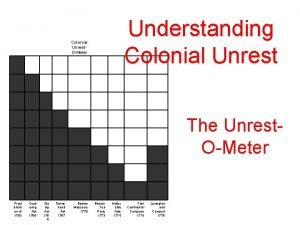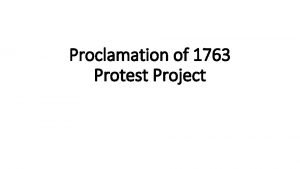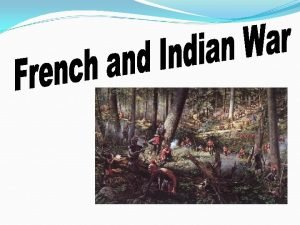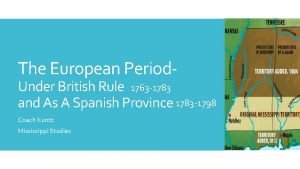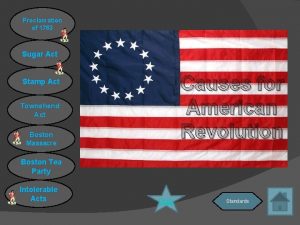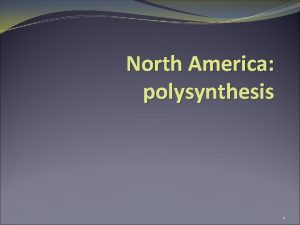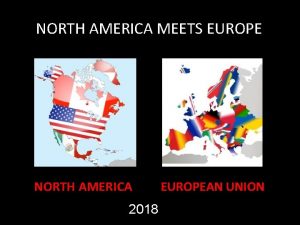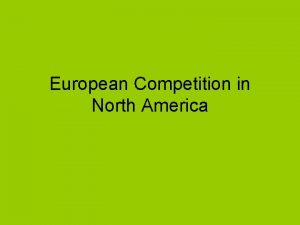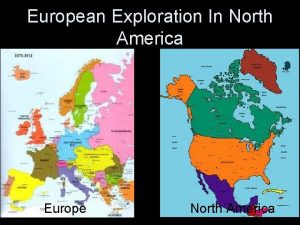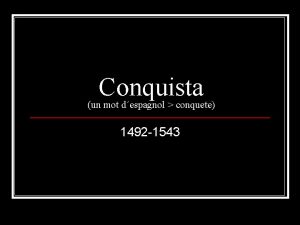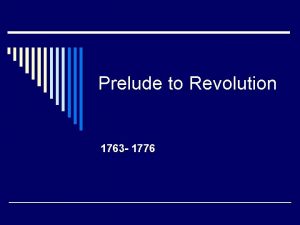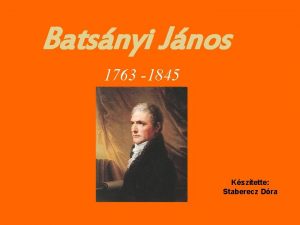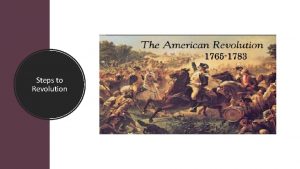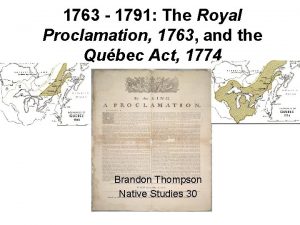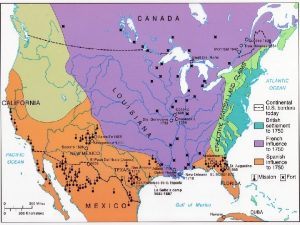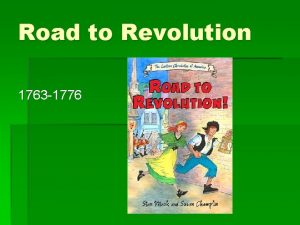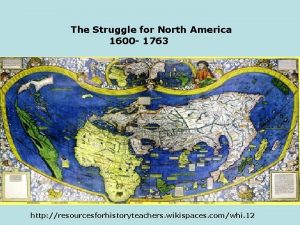European Colonizers of North America 1492 1763 I



















- Slides: 19

European Colonizers of North America, 1492 -1763 I. Colonization, not Assimilation How did the U. S. Become an Offshoot of Europe, particularly England? II. Sources of European Expansion - The Things Europeans Had in Common Renaissance Curiosity; Christian Expansiveness; Growth of Commerce; Growth & Consolidation of National Monarchies in western Europe; Ideologies that Justified Colonization, Enslavement - The Things That Differentiated Europeans Competition for Souls, Territory, Wealth; Different Levels of Preparation to Colonize; Different Approaches to Colonization III. Rivals for North American Territory Spain (Central America, Mexico, the Southwest) France (Canada, Mississippi Valley) England (The 13 Colonies along the Atlantic Seaboard) IV. What roles would Native peoples have in European colonial systems? Could they become something like “citizens”?

Pope Francis (left) in Sept. 2015 canonized Father Junipero Serra (right), founder of Spanish missions in California

Excerpt from Pope Francis’s homily during canonization of Junípero Serra, Sept. 23, 2015 Father Junípero Serra…was the embodiment of “a Church which goes forth, ” a Church which sets out to bring everywhere the reconciling tenderness of God. Junípero Serra left his native land its way of life. He was excited about blazing trails, going forth to meet many people, learning and valuing their particular customs and ways of life. He learned how to bring to birth and nurture God’s life in the faces of everyone he met; he made them his brothers and sisters. Junípero sought to defend the dignity of the native community, to protect it from those who had mistreated and abused it. Mistreatment and wrongs which today still trouble us, especially because of the hurt which they cause in the lives of many people.

Pope Francis (left) in Sept. 2015 canonized Father Junipero Serra (right), founder of Spanish missions in California

“Erected in the aftermath of the California mission era, San Francisco’s Early Days statue depicts a Native American on his back, defeated, a Catholic priest above him pointing to the heavens, and an anglicized vaquero bestriding the scene in triumph. The statue was part of the Pioneer Monument celebrating the state’s origins. Native Americans saw it as dehumanizing art but no one had managed to convince politicians to take it down. It wasn’t until gender- and racially-diverse city boards, as well as backlash against Eurocentric depictions of dominance, that change came. ” The Guardian 9 -24 -2018

Early Days was disassembled and removed during nighttime in mid. September, 2018, and then taken to an undisclosed location. The city of San Francisco was and is being sued for taking this action. Critics argued that works of art should not be altered or hidden from view.

It is not just the Pope and California! Consider what happened during 2017 in Edmonds (a suburban town 20 minutes north of Seattle). The Edmonds City Council debated what to do with Columbus Day is a federal holiday. But around the country, and especially in the West, people have questioned whether it made sense to celebrate Columbus’s achievement, and often decided to rename the holiday to recognize the fate of peoples who were victimized by European discovery and colonization. The Edmonds mayor and the city Diversity Commission had called for a resolution that would make the 2 nd Monday in October “Columbus Day and Indigenous People’s Day. ” The City Council refused to go along with this, and passed a revised resolution that made the 2 nd Monday in October “Indigenous People’s Day. ” The Council agreed that Columbus’s voyage had “opened the door to displacement and genocide of the native population, ” but disagreed over whether Columbus himself deserved recognition—and how much.

Yesterday: “The past is a foreign country. They do things differently there. ” Today: “The past is never dead. It's not even past. ” William Faulkner

European Expansion to North America, 1492 -1763 I. Colonization, not Assimilation How did the U. S. Become an Offshoot of Europe, particularly England? II. Sources of European Expansion - The Things Europeans Had in Common Renaissance Curiosity; Christian Expansiveness; Growth of Commerce; Growth & Consolidation of National Monarchies in western Europe - The Things That Differentiated Europeans Competition for Souls, Territory, Wealth; Different Levels of Preparation to Colonize; Different Approaches to Colonization III. Rivals for North American Territory Spain (Central America, Mexico, the Southwest) France (Canada, Mississippi Valley) England (The 13 Colonies along the Atlantic Seaboard) IV. What roles would Native peoples have in European colonial systems? Could they become something like “citizens”?

European Population Movements after 1492

Key Activities for Long-Distance Colonization 1) Seafaring 2) Conquest 3) Planting In Europe of 1450 -1650, Spain and Portugal had done the most to develop these abilities.

The Treaty of Tordesillas, 1494, was intended to divide up colonial possessions between Portugal and Spain.

Spain in the Americas, 15 th through 18 th centuries

Spanish Northern Frontiers, 1600 -1800

Spanish & Mexican California, 1769 -1833 -the Mission System, from San Diego to San Francisco, was conceived and launched by Junipero Serra, 1769 -84

European Settlements, Eastern North America, 1742

French Inroads into the Continent

European Claims to North America, 1763— France has been defeated and evicted, leaving Spain and England as the main rivals

Comparative Population Growth in North America by 1750 New France: 55, 000 New Spain: 860, 000 English Colonies: 1, 250, 000 (including Africans)
 North america map 1750
North america map 1750 European colonies in north america
European colonies in north america Chapter 20 section 1 world history
Chapter 20 section 1 world history European claims map
European claims map Chapter 20 section 2 european nations settle north america
Chapter 20 section 2 european nations settle north america European nations settle north america chapter 20 section 2
European nations settle north america chapter 20 section 2 Chapter 20 section 2 european nations settle north america
Chapter 20 section 2 european nations settle north america European colonies in north america
European colonies in north america European nations settle north america chapter 4 section 2
European nations settle north america chapter 4 section 2 America asia africa
America asia africa Thomas barnard sermon massachusetts 1763
Thomas barnard sermon massachusetts 1763 Ohio river valley 1763
Ohio river valley 1763 Why did the colonists hate the proclamation of 1763
Why did the colonists hate the proclamation of 1763 Proclamation of 1763 caricatures
Proclamation of 1763 caricatures Proclamation of 1763 picture
Proclamation of 1763 picture Proclamation of 1763
Proclamation of 1763 Proclamation of 1763 protest
Proclamation of 1763 protest Ohio river valley 1763
Ohio river valley 1763 Under british rule, 1763-1783
Under british rule, 1763-1783 Proclamation of 1763
Proclamation of 1763
